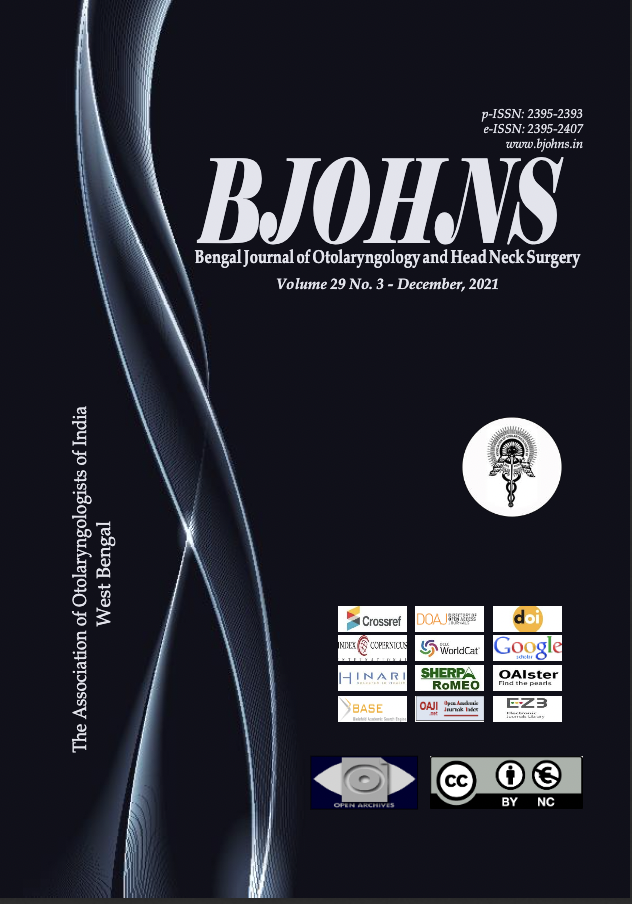Asymptomatic Middle Ear Dysfunction in Children with Upper Respiratory Infection – Analytical Cross Sectional Study
Main Article Content
Abstract
Introduction
Otitis Media with Effusion (OME) is the commonest cause of hearing difficulty and one of the most frequent reasons for elective admission to the hospital for surgery during childhood. The condition starts with dysfunction of middle ear due to poor ventilation through Eustachian tube or extension of the inflammatory process from nasopharynx. In the natural history of the disease, there may be a period of the pre-clinical stage without symptoms or signs of OME. If the disease is identified in this stage, the further sequel of it (like persistent hearing difficulty or retraction pocket formation) may be prevented.
Materials and Methods
A hospital based analytical cross-sectional study was conducted among the children below 12 years of age to assess the middle ear function (by tympanometry) in children having upper respiratory tract infection (but no ear related complaints) and comparing them with the middle ear function in children not having such infection or any recent history of the same. Age and sex matched control group having no such symptoms was constructed. There were 25 children in both study and control group selected from Otorhinolaryngology and Pediatrics outpatient department (OPD). So total numbers of children were 50.
Results
There was no statistically significant difference in background characteristics (age, sex) of the of study and control groups. There was no statistically significant difference when the tympanic membrane retraction or middle ear pressure is taken into account. But significant difference found in the parameters like middle ear compliance (68% children have low compliance in the study group vs 20% in control, with df= 1, ϰ2 = 11.688 and p value was 0.001) and tympanogram curve type (48% in study group have B or C type and 8% have such in control group).
Conclusion
Early diagnosis of the middle ear dysfunction among the children with upper respiratory infection, by clinical examination and suitable audiological investigation in the pre-clinical stage with appropriate intervention can prevent further progression of the disease, causing hearing loss as well as retraction pocket formation.
Article Details

This work is licensed under a Creative Commons Attribution-NonCommercial 4.0 International License.
References
Fria T, Cantekin E, Eichler J. Hearing acuity of children with otitis media. Arch Otolaryngol. 1985; 111: 10-6
Magnuson B. Tubal closing failure in retraction type cholesteatoma and adhesive middle ear lesions. Acta Otolaryngologica 1969; (Suppl 263): 25-8
Hinton AE. Surgery for otitis media with effusion in children and its relationship to parental smoking. The Journal of Laryngology and Otology 1989; 103. 559-61
Silverstein H, Miller GH, and Lindeman RC. Eustachian tube dysfunction as a cause for chronic secretory otitis in children. Laryngoscope 1966; 76: 259-73
Bluestone CD, Klein JO. Diagnosis. In: Bluestone CD, Klein JO, ed. Otitis media in infants and children. 2nd Ed. Philadelphia: W.B. Saunders Company, 1995: 89-144
Biswas A. Impedance Audiometry. In Clinical Audio-Vestibulometry. 5th Edition. Bhalani Publishing House, Mumbai, India. Page 78-148
Sadé J. Atelectatic Tympanic Membrane: Histologic Study. Annals of Otology, Rhinology & Laryngology 1993; 102(9):712-716. doi:10.1177/000348949310200912
Jerger J. Clinical experience with impedance audiometry. Arch Otolaryngol. 1970; 92(4):311-24
Bluestone CD. State of the art: definitions and classifications. In: Liu DJ, Bluestone CD, Klien JO, Nelson JD (eds). Recent advances in otitis media with effusion. Proceedings of the 3rd International Conference. Ontario: Decker and Mosby; 1984
Hall-Stoodley L, Hu FZ, Gieseke A, et al. Direct detection of bacterial biofilms on the middle ear mucosa of children with chronic otitis media. J Am Med Assoc. 2006; 296: 202-11
Saylam G, Cadalli E, Tatar E, et al. Association of adenoid surface biofilm formation and chronic otitis media with effusion. Arch Otolaryngol Head Neck Surg. 2010; 136: 550-5
Tos M. Epidemiology and natural history of secretory otitis. Am J Otol. 1984; 5(6):459-62
Bhat V, Mani I P, Aroor R, Saldanha M, Goutham MK, Pratap D. Association of asymptomatic otitis media with effusion in patients with adenoid hypertrophy. Journal of Otology 2019; 14(3):106-10
Chonmaitree T, Revai K, Grady JJ, Clos A, Patel JA , Nair S et al. Viral Upper Respiratory Tract Infection and Otitis Media Complication in Young Children, Clinical Infectious Diseases 2008; 46(6): 815-23.

